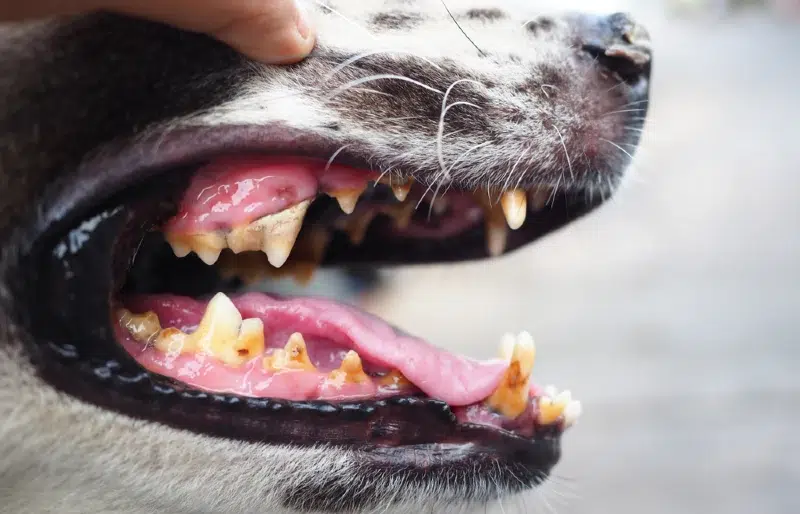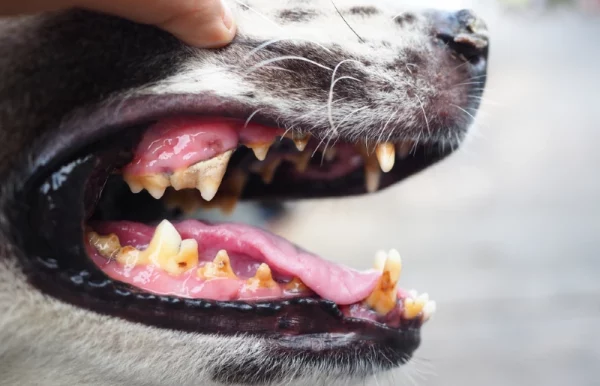Click to Skip Ahead
Tooth resorption is a common disease in dogs and represents the loss of tooth structure. It occurs when the body removes tissue that contains minerals. As a progressive disease, it leads to the loss or destruction of teeth.
Resorption can affect all the parts of a tooth, including the pulp, the cementum (which covers the root), the dentin (the layer found under the enamel), and the root.
Tooth resorption is usually not visible on the surface. Only X-rays can show if your dog suffers from the condition. This dental problem can also lead to infection, fracture, tooth loss, and other issues that can cause lasting damage to the teeth, gums, and jaw.

What Is Tooth Resorption?
Tooth resorption is of two types: internal and external, each with its own subcategories. This oral anomaly is frequently found in older large-breed dogs 1.
Internal resorption is less common compared to external resorption. The dentin or cementum begins to be absorbed into the tooth canal, causing the inner and outer surfaces of the tooth to become inflamed.
External resorption can affect any part of the outside of the tooth, from the roots to the cementum outside. Sometimes it can be difficult to differentiate between the two types of tooth resorptions.
Studies show that the most common subtypes of tooth resorption in dogs are external replacement resorption and external inflammatory resorption 2. External cervical root surface resorption, external surface resorption, and internal surface resorption are not that common in dogs.
Lesions can appear on any tooth, but the premolars of the lower jaw are particularly affected. This condition is usually not visible to the naked eye and must be diagnosed through radiological examination (X-rays) 3.

What Are the Signs of Tooth Resorption in Dogs?
Tooth resorption in dogs has no external signs, meaning nothing is visible on the tooth. When the dentin (the layer found under the enamel) is exposed, this condition becomes painful.
- Muscle spasms
- Tremors of the jaw
If tooth resorption occurs at the root, dogs may not show any clinical signs. If resorption occurs above the gum line, dogs may experience discomfort and pain.
- Mouth bleeding
- Hypersalivation
- Difficulty eating
- Tooth fracture
Many dogs will swallow food unchewed because tooth resorption causes them pain. This behavior is often misinterpreted as an increased appetite.
Other dogs prefer to chew only on one side, while some pets prefer solid food instead of soft food. Soft/wet food can stick to their teeth and cause discomfort and pain.
Occasionally, dogs will stop eating and may show obvious signs of pain: excessive salivation, discomfort to the touch, and food dropping from their mouth.
What Are the Causes of Tooth Resorption in Dogs?
Although there are many theories regarding what causes tooth resorption in dogs, the truth is that the exact cause is not known.
Regardless, tooth resorption leads to the erosion of dentine and cementum, reaching the pulp of the tooth. At the microscopic level, during tooth resorption, the odontoclasts break down the hard tissue of the tooth. Odontoclasts are large, multinucleated cells with cytoplasm rich in cell organelles, as they are specialized in the process of root resorption.
When the crown is affected, the disease becomes painful for dogs and causes discomfort, and the defects created in it will become entry gates for oral bacteria.


How Do I Care for a Dog With Tooth Resorption?
If your dog shows signs of an oral problem, take them to the vet. Tooth resorption is diagnosed through X-rays. In the early stages of the disease, the gums may cover the defect, and the veterinarian will not see that there is something wrong with your pet’s teeth.
There is a recommendation to give solid food to your dog so they use their teeth more, but this has not been proven to be an effective prevention method. Since the causes of the occurrence are unknown, there may not be a way to prevent the onset of the disease.
Also, if your dog suffers from tooth resorption, more teeth will be affected in the future. The only way to detect the condition in time is through regular dental check-ups.

Frequently Asked Questions (FAQs)
Can Tooth Resorption Be Reversed in Dogs?
In some cases, stopping or decreasing the progression of tooth resorption in dogs can be done through root canal therapy. As with humans, this involves cleaning the pulp of the affected tooth and filling it with dental material. That said, the preferred method of treatment for pets is to remove the affected tooth/teeth altogether; once the tooth resorption is exposed in the oral cavity, bacteria can enter the tooth, which will lead to inflammation and infection.
How Serious Is Tooth Resorption in Dogs?
Tooth resorption in dogs is a serious medical condition because it can lead to changes inside the oral cavity, including infections, tooth loss, or tooth pain. It can also cause damage to the gums, jaw, and teeth. If your dog shows signs of an oral problem, take them to the vet for a dental checkup.

What Are the Types of Resorptive Lesions?
There are three types of resorptive lesions, two of which are abnormal. These are physiological (normal), inflammatory, and non-inflammatory. In physiological resorption, the dog’s body prepares to replace baby teeth with permanent teeth.
Inflammatory and non-inflammatory resorption lesions have unknown causes, and large and older breeds are more prone.
Conclusion
Tooth resorption in dogs is a common dental condition that especially occurs in older large breed dogs. This condition has two types: internal and external. The external type of tooth resorption in dogs is the most common. This condition cannot be prevented, and treatment usually consists of extracting the affected tooth/teeth to prevent the infection from entering the oral cavity. It has no obvious clinical signs, and most of the time, nothing is visible on the surface of the tooth. Tooth resorption usually can only be diagnosed via radiographic examination, so regular dental check-ups are recommended.
Featured Image Credit: Kasang.Foto, Shutterstock












